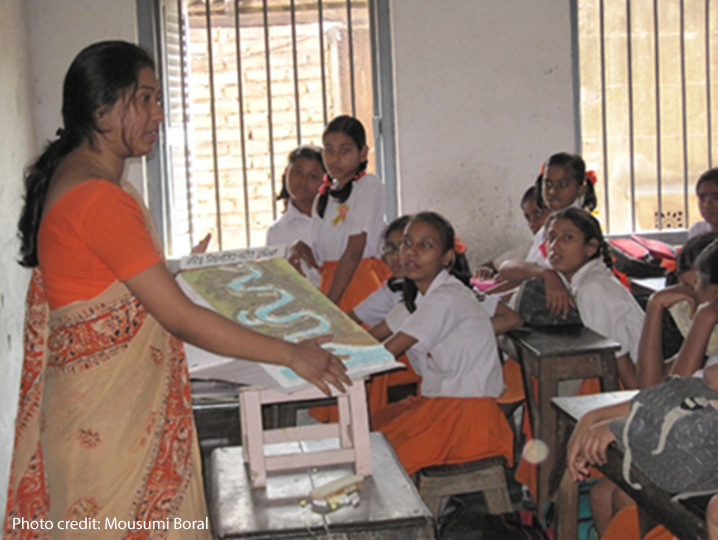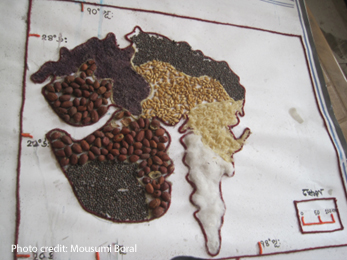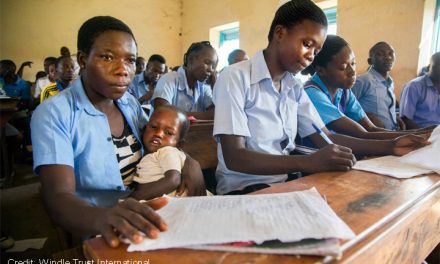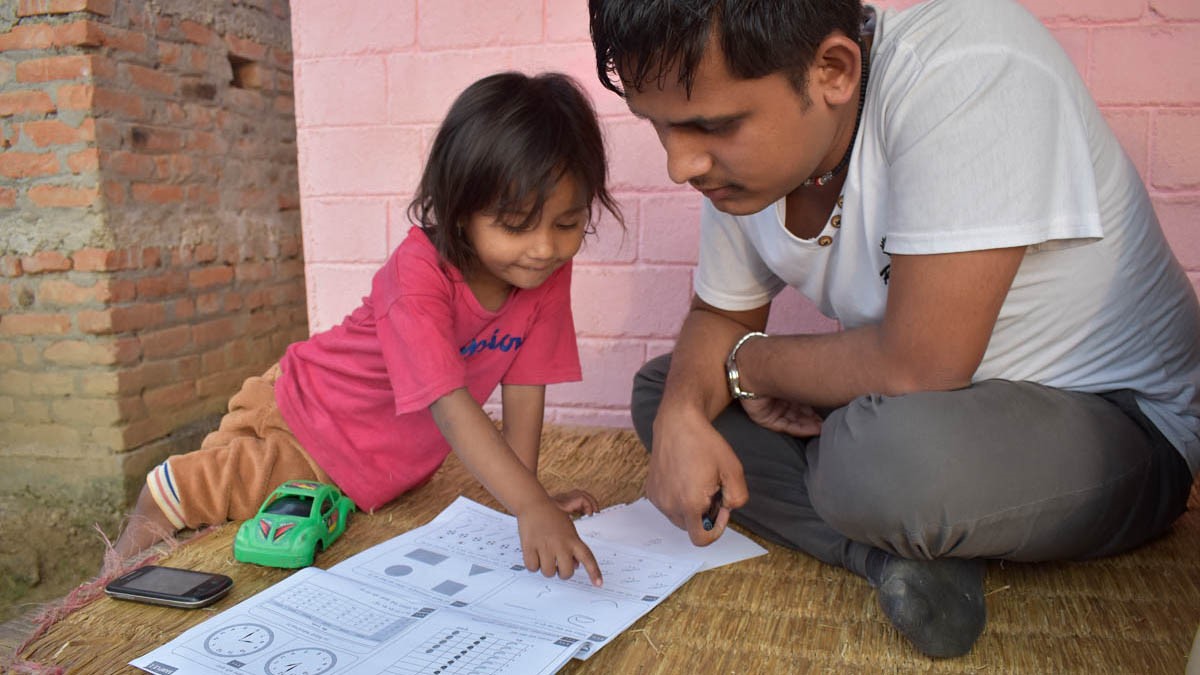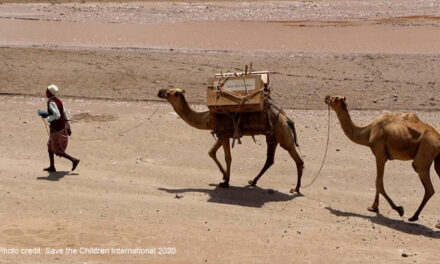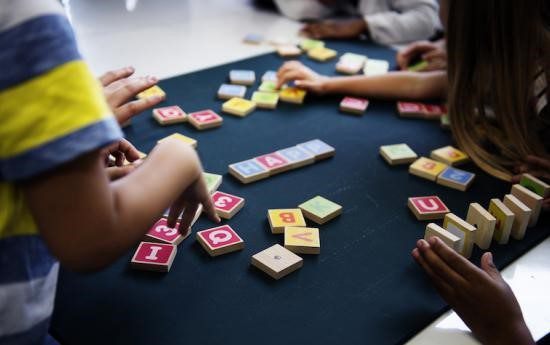This blog was written by Dr Mousumi Boral, an Associate Professor in Geography, Kolkata, India. Her expertise is in innovative teaching-learning techniques for visually-impaired learners. She is engaged in the training of teachers and supervises doctoral research. For the 2023 UKFIET conference, 32 individuals, including Mousumi, were provided with bursaries to assist them to participate and present at the conference. The researchers were asked to write a short piece about their research or experience.
This blog explores the transformation of geography education for visually-impaired learners. Geography learning is about understanding differences, recognising similarities, and celebrating diversity in class or out of school. Geography is a discipline that needs to be observed, visualised, and perceived to interact through concrete experiences. The visually-impaired learners who are also global citizens, require personal development but struggle to access learning materials.
Three pertinent issues arise–
- How would visually-impaired students learn about the geographical elements?
- How would they imagine the geographical elements?
- How would constructivism take place in them for the future?
- How would visually-impaired students learn about the geographical elements?
In the initial years, a visually-impaired child relies on additional verbal description and discrimination (voice tone, rhythm of speaking, pauses in delivery) and requires alternative learning methods and hands-on experience for concept mapping.
Vivekananda’s Complete Works (Volume 4) inspires – ‘The only true teacher is he who can convert himself, as it were, into a thousand persons at a moment’s notice……..who can immediately come down to the level of the student, and transfer his soul to the student’s soul and see through the student’s eyes and hear through his ears and understand through his mind. Such a teacher can really teach and none else.’ Thus, we need to highlight the need for teacher educators who deeply connect with their students and play a pivotal role in this transformation. In the crucible of wisdom, teacher educators forge as reflective practitioners, honing their pedagogical and technological competence like artisans perfecting their craft.
The art of self-reflection becomes a sanctum of growth, as teachers learn to harmonise their teachings to resonate with the diverse needs of their learners. The education of visually-impaired children requires the sensitivity of educators (based on attitudes, aspirations, and motivations) and counselling raises self-esteem and psycho-social development and ensures better mobility and orientation. Constraints of Learning Resources hinder visually-impaired learners’ special education support in populous developing countries as they face limited access to assistive tech, training, and relevant study materials, along with awareness gaps, inequitable service distribution, and administrative challenges impact.
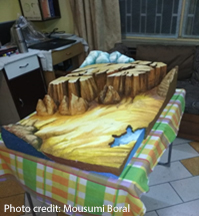 Therefore, the preparation of cost-effective (low cost/no cost) tactile geography learning aids using indigenous/locally available resources, rather than reliance on technology for classroom transaction and inquiry-based learning, empowers. This is especially so for economically-challenged visually-impaired learners through: ensuring accessibility (bridging the digital divide) and sustainability and scalability, enabling wider implementation, even in resource-constrained settings. Low-cost aids invigorate sensory exploration for visually-impaired learners, fostering self-awareness and metacognition. They promote inclusivity in classrooms and empower learners to contribute effectively to community problem-solving, offering unique perspectives and insights. Low-cost aids make geography education affordable for low-income visually-impaired learners, removing financial barriers to accessing essential learning resources.
Therefore, the preparation of cost-effective (low cost/no cost) tactile geography learning aids using indigenous/locally available resources, rather than reliance on technology for classroom transaction and inquiry-based learning, empowers. This is especially so for economically-challenged visually-impaired learners through: ensuring accessibility (bridging the digital divide) and sustainability and scalability, enabling wider implementation, even in resource-constrained settings. Low-cost aids invigorate sensory exploration for visually-impaired learners, fostering self-awareness and metacognition. They promote inclusivity in classrooms and empower learners to contribute effectively to community problem-solving, offering unique perspectives and insights. Low-cost aids make geography education affordable for low-income visually-impaired learners, removing financial barriers to accessing essential learning resources.
These aids promote inclusivity and affordability, ensuring all learners, regardless of their background, can actively participate and engage in the learning process. Hands-on tactile learning enhances comprehension, a sense of ownership and exploration. The ability to identify available indigenous resources for geography education bridges contexts and backgrounds, and stimulates multi-sensory engagement of their cognitive, affective, and psychomotor domains, resulting in meaningful learning experiences and greater independence. The approach of active learning for all integrates UNESCO’s four pillars of education, engaging Geography Teacher trainees (who have completed undergraduate/postgraduate) for fostering a holistic and transformative learning experience.
- How would they imagine the geographical elements?
In the ‘Ask Phase’ the students are empowered to select topics, consider diverse perspectives, collaborate in teams, and craft insightful questions regarding low-cost tactile learning resources. In the ‘Collect Phase,’ the importance of addressing fundamental physiological and safety needs, which is crucial for creating a conducive and secure learning environment for visually impaired learners is pursued (Maslow’s Hierarchy of Needs). Consequently, trainees acquire information through surveys of the needs of low-cost aids and diverse strategies aiding visually-impaired geography learners – like tactile maps and live specimens that cater to spatial intelligence.
This aligns with inclusive education, reflecting Gardner’s Theory of Multiple Intelligences emphasising diverse strengths and collective involvement. The ‘Visualise Phase’ is guided by tenets of Dewey’s Experiential Learning model that applies to active participation and engagement, whereby learners reflect on their experiences, connecting theory with practice, leading to transformative learning and personal growth. For instance, a geography teacher might use tactile resources to bridge the gap between a visually impaired student’s current understanding and the desired level of comprehension. Vygotsky’s Zone of Proximal Development in Sociocultural Theory encourages diverse learning styles and abilities by using low-cost aids for curriculum-aligned content visualisation, empowering students for both co-existent work cohesion and deep reflection. This highlights the importance of social interaction and collaboration in the learning process, facilitating higher-order thinking through social constructivism and IEP.
Aligning the efforts with the UNESCO’s Education for Sustainable Development for 2030, the ‘Create Phase,’ develops a blueprint for geography lessons, built on hands-on, experiential learning. This is particularly beneficial for visually-impaired learners for actively engaging with and comprehending geographical concepts, as emphasised by Jerome Bruner’s constructivist theory. In the ‘Act Phase’, we forge robust community linkages, drawing from insights in global commission reports, particularly the UNESCO Global Education Monitoring Report. We emphasise the importance of powerful storytelling through structured presentations (employing a SWOT analysis approach), creating shared resources, promoting a culture of cooperative learning and collaborative learning nurturing responsible and compassionate individuals. Incorporating field trips to real-world environments can help dispel stereotypes to promote integration and generate critical thinking and problem-solving skills, a central element of Bloom’s taxonomy of educational objectives.
- How would constructivism take place in them for the future?
The concept of metacognition contributes to facilitating responsible inquiry and scaffolding students’ learning effectively. Albert Bandura’s Social Learning Theory enables Problem-Based Learning (PBL) and adult learning within the communities. A lot of research, huge sensitisation, and awareness programmes of active experimentation need to be done to sensitise these trainee teachers at every point for Transformative Learning.
A visually-impaired learner simply needs a true teacher who would constantly guide them to observe details in the immediate environment and lead from an unknown to the known path of knowledge in a programmed manner. A true and dedicated geographer teacher will imbibe that mindset, firm determination, and a reflective spirit, to contribute at least to a single learner, if not a community more widely. The mission of inclusion is to be extended so that a visually-impaired teacher can be an eye-opener to another visually-impaired learner. Eco-psychology underscores ecological consciousness for personal and planetary healing, aligning with the 2030 Report’s call for geographers to address global crises through Education for Sustainable Development (ESD).
Geographers, as active participants, leverage their expertise to foster a sustainable future. The butterfly effect concept signifies the profound interconnectedness of the world, highlighting how small actions can lead to significant consequences. Geographers, acting as proactive change agents of sustainable development, are essential in addressing global crises through micro-level management by harmonising emotion and cognition to meet diverse learner needs, embracing a boundless world as their classroom.

